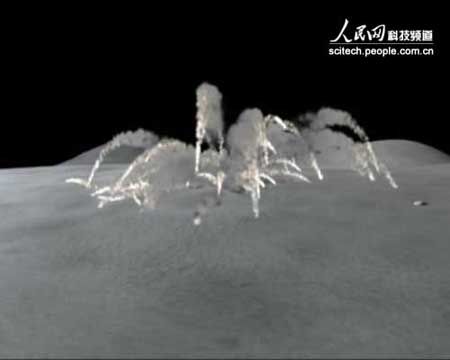The spacecraft completed the 16 months of the moon's orbit and transmitted to Earth images and maps of the distribution of resources on the moon * The next step - launching spacecraft that will make a soft landing, and in eight years - spacecraft that will return soil samples from the moon

The first Chinese spacecraft to orbit and explore the moon, Shenjia 1 completed its mission and crashed on the moon after 16 months of orbit.
The Shanghai 1 spacecraft hit the lunar surface on Sunday at 16:13 China time (10:13 Israel time). The spacecraft was launched in October 2007 from the Shichang Satellite Launch Center. It is considered the first of three steps in the Chinese lunar plan.
During the last 16 months the spacecraft has been transmitting Over 1,400 gigabytes of scientific data including images of the Moon, images of the Moon's surface and maps of the distribution of elements on Earth's natural satellite.
Ouyang Zhihuian, Chief Scientist says: “We have achieved our four main goals for this program, thanks to the hard work of our scientists. I believe that these goals have been accomplished for the best. Some of the tasks even achieved more than expected.
The data transmitted by Shanghai 1 to Earth was provided for free to Chinese scientists. 124 scientists from about 70 colleges and 30 institutions from all over China who formed a central committee to analyze the data. After about a year, the data will also be given to scientists from all over the world.
China also announced yesterday (Monday) that it plans to land an unmanned spacecraft on the moon in 2013. Ye Paijian, the chief planner of the Shenjia-1 mission, the first Chinese lunar probe. The mission that Shanghai-3 will feature will include a soft landing of a spacecraft on the moon, says Ye, a member of the 11th National Committee of the Chinese Communist Party, China's top scientific advisory body. Before the mission, the Shenja 2 spacecraft will be launched in 2011 with the aim of testing technologies for a soft landing and reducing the technological risk. said.
The schedule was tested as China completed the first of three stages in crashing the Shanghai spacecraft on the moon on Sunday. According to Yeh, the stages are the coffee, landing and the stage of returning soil samples. Still during the second phase, the Shenja 4 spacecraft will be launched and this phase will not end before 2017, Yeh said, without specifying what the missions of the fourth spacecraft are.
According to Yeh, the third phase will take place between 2017 and 2020, during which China will launch spacecraft that can also return to Earth.
Shenja is the goddess of the moon in Chinese mythology, but according to Ye, it is possible that the spacecraft that will return samples from the moon to Earth will no longer be named after her, but this has not yet been determined."
The Chinese space program knew an important milestone last year with the third manned launch that also included space walk.

6 תגובות
Completely disturbed 🙁 I can't even see the moon with my eyes now
We will become a waste site. Luckily I won't be here for another 100 years
to see it
criminals!!
🙁
There is a movie "The Time Machine" where as a result of such an event damage is done to the moon and the results caused to the moon are examined in an interesting way.
LOL
I liked 3..
But..seriously..isn't it harmful to the moon that satellites crash on it? hook
As if they would use the gravitational orbit and just fly it outside the solar system no... at most it will collide with an asteroid... less terrible haha
For 1 you are right it should have been smashed on the nuclear reactor in Iran
Typical Israeli behavior.
Why smash it on the moon?
Is it not harmful in any way?